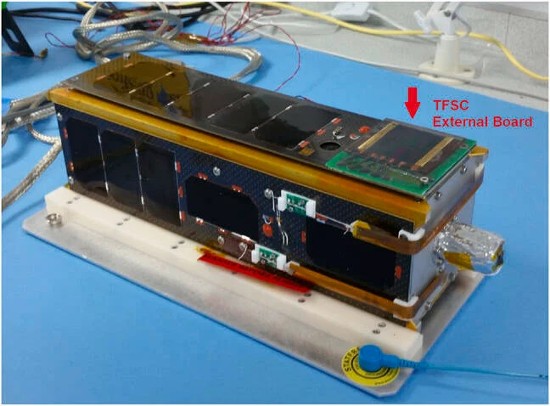Can We Power the Entire Planet From Space?
Researchers at the University of Surrey and Swansea University along with engineers in training from the Algerian Space Agency collaborated in building a cubesat that featured solar test panels. It was launched into space in September of 2016. Seven years later the results have been published.
The cubesat’s solar cells were made from a lightweight stable crystalline compound containing cadmium and tellurium. The compound was laid down on extremely thin glass. The picture above shows you the cubesat during construction.
In a press release that accompanied the online release of the paper that will appear in the December issue of Acta Astronautica, Craig Underwood, Emeritus Professor of Spacecraft Engineering at the Surrey Space Centre, University of Surrey states:
“Detailed data show the panels have resisted radiation and their thin-film structure has not deteriorated in the harsh thermal and vacuum conditions of space. This ultra-low mass solar cell technology could lead to large, low-cost solar power stations deployed in space, bringing clean energy back to Earth – and now we have the first evidence that the technology works reliably in orbit.”
Solar cells when exposed to the vacuum and harsh extreme temperature conditions in space delaminate over time. But not these. The expectation of the designers was they would work for a year. Today, they are still going strong.
Cadmium Telluride is Not New Technology
Cadmium telluride (CdTe) is the second most commonly used material found in solar cell technology here on Earth. Crystalline silicon photovoltaics dominate the market and are found powering satellites, the International Space Station (ISS), and China’s Tiangong. They are the solar panels found on most home roofs today.
So where is CdTe deployed? Currently, the technology represents approximately 5% of the total installed solar panel base today. Large commercial solar farms use CdTe. Prior to the cubesat launch, no CdTe cells had been deployed in space.
Not everything has worked perfectly on the cubesat. There are needed changes to perfect the technology for deployment in space. Although the cells have proven to be resilient, the back contact architecture needs reworking because the cells fill factor (FF), a key measure to evaluate efficiency has shown decreases over time.
FF is calculated by dividing the maximum power possible from a cell by its actual output. With the cubesat there have been noted decreases in shunt resistance effecting how much of the power actually gets harvested. The problem points to the interface which uses gold as a contact material between the back panel and the CdTe cells. The design team, however, believes a solution already exists in CdTe panels deployed here on Earth and plans to make changes in the next cubesat experiment.
Is Energy from Space No Longer Science Fiction?
Solar panels on Earth today convert between 20 to 30% of the energy gathered from sunlight into electricity. In space, solar panels are thirteen times more efficient. That’s why there is a high interest in harvesting solar energy produced in space and beamed to Earth.
Current solar panels deployed on ISS and Tiangong station require supplementary battery storage for backup because both of their orbits pass through Earth’s shadow half the time.
For solar power from space, the intermittency problem that the two space stations experience can be solved two ways. The first approach would be to deploy a solar farm in geostationary orbit where Earth’s shadow would never impede sunlight. The second approach would deploy a constellation of small solar satellites similar to the SpaceX Starlink mesh network being buit for continuous telecommunications service delivery to anywhere on the planet.
The remaining challenge would be getting the power back to receivers on Earth. Technological solutions are already being tested. Back in August 2023 a posting on this site described the results from a Caltech-deployed satellite using a microwave array to demonstrate how solar energy collected in space could be converted to microwaves, and sent to a receiver on Earth. This technology could be used for both previously described approaches to space-based solar power generation.
How far in the future do we have to wait before solar power from outer space becomes an Earth-based reality? As we have described, the technology pieces are already being put in place for future pilot deployments, likely before the end of this decade.
It is conceivable that by mid-century that cities, industry, and homes anywhere on the planet will be on the direct receivng end of power generated this way. What a different world it will be with the democratization of energy available for all.










[…] Power for deployment on Earth. Work at two United Kingdom universities has been ongoing to create mass solar technology at a low cost. Caltech in the United States launched a prototype solar energy satellite, the Space Solar Power […]